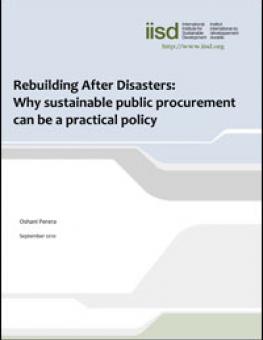
Rebuilding After Disasters: Why sustainable public procurement can be a practical policy
IISD has developed a preliminary consultation paper that is designed to foster stakeholder discussion on if and how sustainable public procurement can be deployed to promote development and cohesion in a post-disaster situation.
Generally government spending goes up following a disaster, in order to rebuild the economy and guarantee the livelihood of a country's citizens. The World Bank has estimated that, on average, natural disaster-related recovery and rebuilding costs can consume up to 15 per cent of the affected countries' GDP.
In addition to rebuilding, there is also anecdotal evidence that post-disaster procurement, when executed sustainably, can contribute to disaster risk reduction. This is a particular area demanding further research. Both a challenge in implementing SPP and an opportunity arising from it is the implementation of life-cycle thinking in public policy. Such a mindset is needed for public procurement, as well as for disaster and conflict risk reduction strategies.
You might also be interested in
Green Public Procurement in India
This report analyzes the status of green public procurement (GPP) in India and suggests key strategies for advancing sustainable procurement practices.
The Role of Multilateral Development Banks for Low-Carbon Procurement in the Infrastructure Sector
This report examines the critical role of multilateral development banks (MDBs) in advancing low-carbon procurement within the infrastructure sector.
Green Public Procurement in Indonesia
This report explores the state of green public procurement (GPP) in Indonesia and offers key strategies for advancing sustainable procurement practices.
Monitoring Progress in Green Public Procurement
This report outlines the importance of monitoring progress in green public procurement (GPP) and highlights various methodologies, challenges, and recommendations.